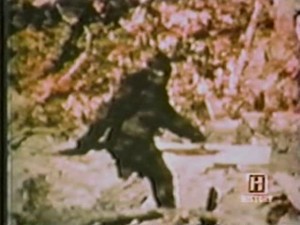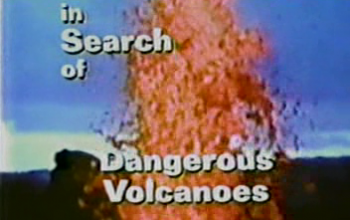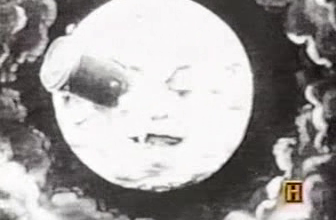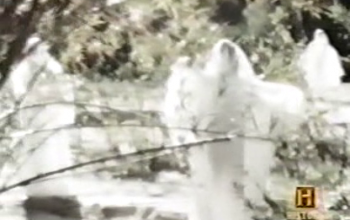In Search Of… S01E05 Bigfoot
Yeah, you heard right! Friggin’ Bigfoot. The big kahuna himself, Sasquatch, the mysterious ape-creature of the North American forests. Episodes arguing that ‘hey, maybe we can kinda-sorta talk to plants‘ are all well and good, but I like my nonsense like my coffee: strong, hairy and hard to capture on film.

I have odd tastes in coffee, is what I’m saying.
When I used to watch this show as a kid, I didn’t really appreciate just what the filmmakers did with nothing. By that I mean the sort of negative space this sort of show occupies. They can’t show Bigfoot, obviously, so what do they do? They have a camera moving through a pine forest, with a soundtrack of ferocious animal noises. Brilliant! The camera can’t observe Bigfoot? The camera will become Bigfoot! Sheer genius. A similar effect was used last week to simulate the POV of a pilot crashing into the Bermuda Triangle, but this is way better.
As the camera does its thing, Nimoy sets out our parameters: Bigfoot is a hairy creature, partway between man and ape. It identified with the Native American figure known as ‘Sasquatch’. The creature is described as gentle, but also sometimes dangerous.
To prove a point, we are shown a charmingly amateurish re-enactment of some Washington miners in 1924, fighting off large hairy apes that attacked their cabin. The whole thing is filmed from inside the cabin, to avoid having to create ape costumes. The Bigfoot growls in this section are pretty lame, though.
We’re then told that the Native Americans of the Pacific Northwest knew all about Sasquatch. This is an interesting question. The assumption of so many of these weird fringe theories is that myths are basically just journalism gone wrong. I’d like to know what modern Native peoples make of this, but Googling for Native American perspectives on Sasquatch just gives me pages and pages of Bigfoot and cryptozoological sites, with the occasional skeptical site mixed in. I’ll keep at it, it might be interesting to find a site on the subject actually written by Native Americans rather than factions of white people. Nimoy tells us that in Native stories, Bigfoot has a mythical significance, and it’s hard to tell “where myth ends and reality begins”, which I guess is code for “we’ll pick and choose which parts of the myth we happen to like.”
Nimoy then stands on top of a building in a cityscape, to deliver a speech about modern man’s distance from the natural world. I don’t talk enough about these little interludes. They’re like performance poetry, except short and not tedious. Part of it is the voice. Leonard Nimoy really does have a very interesting voice. Fascinating, almost. Transcribing what he says doesn’t really do them justice.
We move on… to science! “It is felt by some scientists…” Nimoy begins (because science is all about the feels) that Bigfoot is a hominid, related to humankind. Then we’re talking to Grover Krantz, one of the few serious anthropologists to argue in favour of Bigfoot’s existence. He’s interesting because he talks a lot more fluently than many of the interviewees on the show, and he even has a piece of show-and-tell: a plaster cast of the jawbone of gigantopithicus, an extinct giant ape. The idea that Bigfoot is a modern gigantopithicus is, I gather, still an article of faith amongst many Bigfoot enthusiasts.
Krantz then endorses the famous Patterson/Gimlin film, though his defense of it is a little weak. He claims the ‘Bigfoot’ in the film can’t be a man in a suit because the suit would be too big, though that seems to ignore the possibility of padding. He also claims that when he quizzed Patterson about the film, Patterson claimed not to understand some of the possibilities of fraud that Krantz laid out, though again that does not seem inconsistent with a hoax.
There’s actually a surprising amount of actual, you know, information in this episode. We’re told the supposed range of the creatures (Northern California to British Colombia). They talk about sightings back as far as the early 19th century, and touch on the story of some Canadian railway workers who claimed to have captured one. Nimoy claims that there have been two thousand sightings, but then claims that half are fakes. The other half are real. Putting aside how the filmmakers have arrived at this estimation, it’s unclear where well-meaning people who have honestly misidentified something as a Bigfoot stand in this schema.
The electronic music here gets extra spooky as we get into people delivering their personal accounts of sightings. A driver who saw a Bigfoot run across a road. There’s not much more to his story than that, but the electronic music and zooming Bigfoot POV shots adds a lot to an otherwise bald narrative. A sheriff tells about investigating a report of a large animal and seeing footprints far larger than those of a normal person. Another driver tells of seeing a huge, foul smelling animal. The Northwestern accent of these interviewees is charming, but they all have such flat, phlegmatic attitudes that the music is carrying a heavy load in creating drama.
Next up we talk to Peter Byrne of the Bigfoot Investigation and Information Centre. Byrne is a former big game hunter, who seeks to find (but, critically, not kill) Bigfoot. First up: Byrne talks almost exactly like you’d imagine a big game hunter who formerly worked in Kenya to sound. He says basically that he’s hunting for Bigfoot, and then we’re moving on again.
Two woodsmen talk about seeing a Bigfoot in the woods, and re-enact their own attempt to chase down Bigfoot. One of them shows a sketch he drew of the thing, which is very cool.
Back to Peter Byrne, who’s making a plaster cast of a big footprint, then demonstrates what he sees as the common features of Bigfoot prints. We go back to Krantz who has another such cast, and he gives a little mini lecture on this too, claiming that the skill involved in faking such a thing is so rare and the prints so common as to make fakery impossible.
Byrne shows a bunch of Bigfoot photos which he claims are fake, implying that he’s putting in sincere effort to distinguish real from false evidence. Obviously this implies a degree of skepticism on Byrne’s part, but one wonders it it’s enough.
The next part is really quite interesting. We get away from the question of whether Bigfoot is real and into an ethical grey area. If Bigfoot were discovered, would shooting it be an acceptable way of proving its existence? There was (and I’m told still is) a very deep divide amongst Bigfoot hunters on the subject. We are introduced to the town of Stevenson, Washington, where civic authorities have banned the killing of Bigfoots under penalty of a $10 000 fine or five years imprisonment.
Nimoy claims that the locals are not convinced of Bigfoot’s existence, but are open to the possibility. The local DA seems to back this up, saying that if the creature exists, it has done nothing to deserve being shot. Krantz, on the other hand, believes that nothing short of a body will convince the world about Bigfoot’s reality.
The DA claims that there are many ways to prove the existence of a creature without killing it. Krantz lays out a scenario/highly detailed fantasy in which a hunter has killed a Bigfoot but, not realising what it is, fears punishment and so has kept it quiet. But lacking such an ‘old kill’ it is necessary to kill one now. The DA says that Krantz should reconsider that, especially in his county, because he’s not kidding about that fine. Some other hunters are also for killing Bigfoot, while Byrne is very strongly opposed.
Like I say, it’s an interesting argument, which surely applies to attempts to locate surviving populations of endangered animals other than Bigfoot. Krantz comes right out and says that it doesn’t matter a species becomes extinct if it is unknown to science. Byrne argues that Bigfoot may be a hominid – essentially a human — meaning that killing one is effectively an act of murder.
Next – to my surprise and delight – they ask a Native person her opinion. I feel bad for my earlier side-eyeing of this episode. They talk with Mrs Joe Washington, who says the Sasquatch belongs to the area and teaches the people to live there. “If someone did bring him down,” she says, “it never adapt to your way or even mine, because his way of life is entirely different from ours, mine and yours.” She’s unhappy with Bigfoot hunters, and says that Bigfoot is a man, not an animal. It’s pretty clear that she’s not at all on the same wavelength as Byrne or Krantz
Nimoy begins rounding up. Byrne points out that gorillas and the coelacanth were unknown to science for a long time, which is true, but not necessarily relevant. Yes, biologists are always discovering new species, but that’s no guarantee that any specific undiscovered species exists.
My own feeling on the issue is simply that I strongly doubt that Bigfoot is real. If one is discovered, however… well, I honestly can’t think of a better issue to be proven wrong about, because it would be awesome.
Best quote
Going to skip Nimoy’s narration this time and go straight to Mrs Joe Washington:
“You’ll never be able to you might say civilize him [Bigfoot] like the White Man done to us.”
Like I say, I suspect not. But people will go right on trying.
Summing Up:
Spookiness: 8/10, Crappy Reenactments: 9/10, Occasional Relevant Information: 7/10, Intrusive Electronic Music: 7/10, Nimoyness: 8/10. Total: 41/50. Distinction



